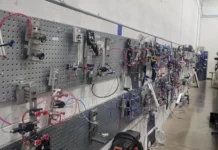by Drew Rosek, TZERO CAE specialist
RJG, Inc.

Part concept and design are vital elements to the molding process. Because of this, manufacturers are highly encouraged to spend additional time analyzing the design before creating the mold. Significant opportunities to decrease waste and time-to-market can be achieved with some up-front work.
Factors that should be well thought out for part design include the following:
- Part and tool design
- Molding machine and performance
- Plastic material selection
- Universal process
This article focuses on part design itself, specifically wall thickness.
The Most Vital Rule
If there was only one rule for the injection molding part design, it would have to be to maintain uniform wall thickness.
Prior to part ejection, injection molded parts must be cooled down from processing temperatures to a point where they are able to maintain their shape and withstand the forces of removal. Once the plastic makes contact with mold steel, it immediately begins to cool. During this period, wall thickness alone is the driving factor in overall part quality (dimensions), solidification time, stress and overall cycle time (time to part ejection).
That said, determining the correct wall thickness for the application can have drastic effects on the cost and production speed of manufacturing. Wall thickness has no set restrictions and will typically be driven by the size and structural requirements of the plastic part, along with the resin type and flow length needed. Choosing a thinner wall can yield overall cycle time reductions at the penalty of some physical characteristics (strength, chemical resistance, flame retardant properties, etc.). Inversely, thicker walls can help with these characteristics while increasing cycle time and manufacturing costs.
Cooling Time

In regard to the effect on cooling time, a general guideline is that cooling time will increase with thickness^2. Why thickness^2? To help explain this, an example will be used with a 2mm wall and 4mm wall (see Figure 2).
When looking at a cross section of the 4mm wall, it can be seen that the heat has twice as far to travel before it can exit the part. The other factor is that there now is twice as much material that’s trying to be an insulator. Thus, whatever cooling time exists with the 2mm section can be multiplied by a factor of four to come up with the new plastic cooling time.
Alternatives
If the part is so complex that variations are needed on the wall thickness, consider alternatives, such as coring or using ribs in areas of concern (see Figures 3 and 4).



Also, remember that sharp corners cause stress concentrations in molded parts (see Figure 5). If transitions in wall thickness must be made, gradual transitions can help reduce pressure losses through the part, giving better overall dimensional control.
Conclusion
There are many creative ways to deal with the trickiest design requirements. The challenge often is in convincing the OEM that the part design needs to be altered to provide a better processing window. The issues that have been discussed thus far simply cannot be “processed out” and can be a burden on the molder for the lifecycle of the tool.
Getting the molder, toolshop and OEM involved and communicating early in the process is key to the overall success of any complex project.
Drew Rosek is an RJG TZERO support engineer/consultant. He collaborates closely with customers through the TZERO process, with an emphasis on simulation and eDART sensor application during a tool launch. For more information, visit www.rjginc.com.




